We often think of crabs as being by the sea, suited for saltwater. However, there are some stunning freshwater crabs around that make an ideal accompaniment to an aquarium. Being scavengers, their behaviors add a different dynamic to a tank, as you can watch them scurrying around, collecting whatever they can get their claws on, which can be very entertaining.
Freshwater crabs tend to be small, ideal for a lot of tank sizes, and they also have the bonus of keeping aquariums clean by doing the job for you. Read on to find out what freshwater crabs are available and how you can incorporate them into your tank!
1. Fiddler Crab
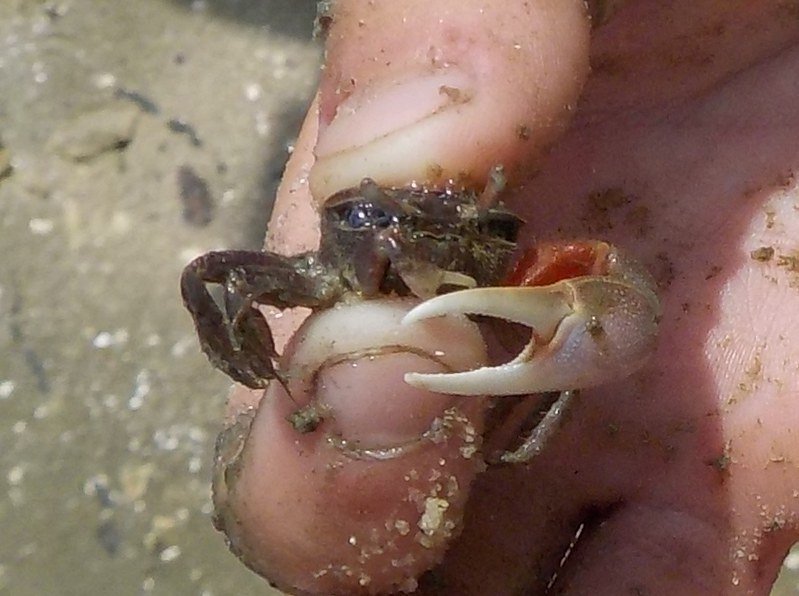
- Family: Ocypodidae
- Origin: West Africa, Western Atlantic, Indo-Pacific
- Scientific Name: Uca Minar
- Common Name: Fiddler Crab
- Diet: Nutritional flakes/pellets and brine shrimp, blood worms, plankton, seaweed, and zucchini
- Size: 2 inches adult size
- Lifespan: 3 years in captivity
- Tank Size: For one to four fiddler crabs, a 10-gallon aquarium
- Temperature: 75-85 °F
- pH: 8.0-8.2
- kH: 12-30
Fiddler crabs spend a lot of time in the water and along the sandy burrows along beaches. They prefer being in the water than out, different from land crabs.
They use their claws to send signals by waving at other crabs when they want to alert them to their presence. Both genders of crabs are distinguished by their claws. Females have small claws, and males have one large big claw that’s held in the same way a fiddler would hold a violin!
They have a calm disposition and are entertaining to keep as pets, requiring little space and open to a range of foods.
2. Thai Devil Crab
- Family: Sesarmidae
- Origin: Southeast Asia
- Scientific Name: Clariosoma Camifax
- Common Name: Thai Devil Crab
- Diet: Nutritional flakes/pellets and brine shrimp, blood worms, fresh & dried fruits, and algae
- Size: 2 to 4 inches adult size
- Lifespan: 5 years in captivity
- Tank Size: 10 gallon
- Temperature: 72-82 °F
- pH: 7.5-8.5
- kH: 8-12
Contrary to the name, these critters are little angels. They sport a vivid purple body, giving them an exotic edge. You’ll also find them in shades of glowing reds and oranges. What’s more, a contrasting red tone on parts of their head and claws make them stand out from their critter crowd.
They have antennae-like eyes that tend to look a little aggressive, but they’re peaceful and only show temper when they are messed about with or to smaller fish. Like many freshwater crabs, they need a dry area with just sand and no water.
3. Vampire Crab

- Family: Sesarmidae
- Origin: Indonesia
- Scientific Name: Geosesarma dennerle
- Common Name: Vampire Crab
- Diet: Nutritional flakes/pellets and brine shrimp, blood worms, dried crickets, and veggies
- Size: 1-2 inches adult size
- Lifespan: 2-3 years in captivity
- Tank Size: 10 gallon
- Temperature: 72-82 °F
- pH: 7.5-8.5
- kH: 10-25
Their glowing yellow vampire-like eyes are what make these crabs eye-catching! Their exotic deep purple coat, pink claws, and white splotches are features many crabs aspire to. They also have a likable personality making them super additions to an aquarium.
If you do house one of these, be careful not to keep them alongside large fish that may consider them as food. You could pair these alongside snails and shrimps or their own species of crab – be careful to always have one male to a few females.
Like many freshwater crabs, they’d need an area of no water to hide and burrow. Be sure to have a substrate of sand for their molting seasons for burrowing into.
Vampire crabs enjoy a varied diet of both plant and protein matter, but they particularly enjoy small crickets.
4. Red Claw Crab
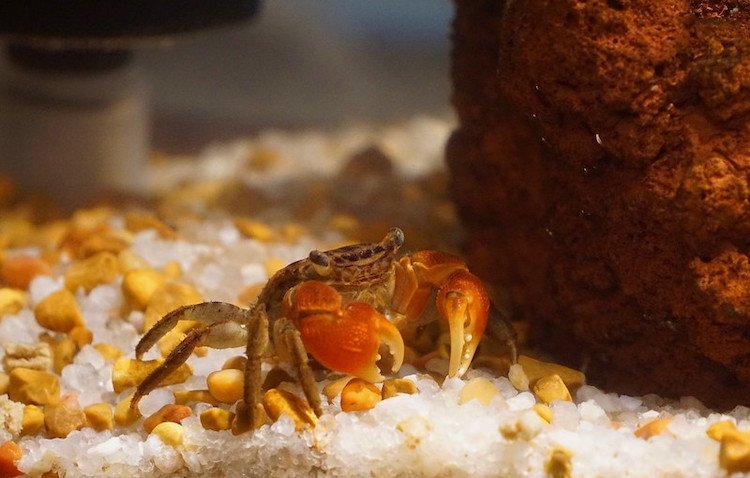
- Family: Sesarmidae
- Origin: Indo-Pacific region from Zanzibar to Japan and Fiji
- Scientific Name: Perisesarma bidens
- Common Name: Red Claw Crab
- Diet: Brine shrimps, fish food pellets and flakes, bloodworms, blanched vegetables
- Size: 2-4 inches adult size
- Lifespan: 3-5 years in captivity
- Tank Size: 10 gallons
- Temperature: 75-80 °F
- pH: 7.5-8.5
- kH: 4-10
Being one of the more readily available freshwater aquarium crabs, the red claw crab is a popular choice. They have a striking red claw that is rather sharp and can do damage.
They can be rather shy in their disposition, but it doesn’t take too long for them to scurry around, explore the tank and come out of their shell.
One thing that’s notable about the Red Claw crab is that they’re territorial, so they need to be housed in a large tank, so they’ve got some space for their me-time. They can be peaceful with other species but can eat up some fish, so avoid keeping fish in the same tank as these crabs.
5. Panther Crab
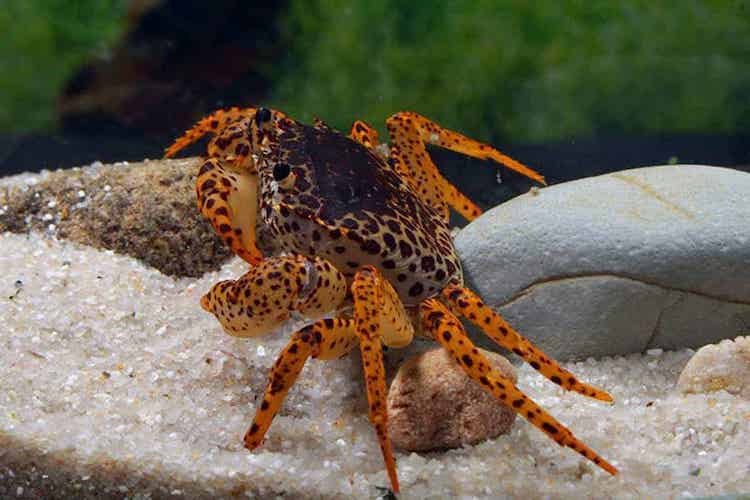
- Family: Gecarcinucidae
- Origin: Indonesia
- Scientific Name: Parathelphusa Pantherina
- Common Name: Panther Crab
- Diet: Brine shrimps, fish food pellets and flakes, dead plant material, and algae
- Size: 3 inches adult size
- Lifespan: 2-3 years in captivity
- Tank Size: 20 gallons
- Temperature: 77-86 °F
- pH: 7.5-8.5
- kH: 4-12
Panther crabs get their name from the print they sport, orange with black spots. They also share a slightly similar temperament to the wild cats being a little aggressive, like the Fiddler crab.
Panther crabs are friendly towards other tankmates to some degree. If they’re not fed properly, they get aggressive and resort to eating tankmates, so if you choose to keep them alongside others, keep them on a good feeding schedule.
Like other freshwater crabs, they require some dry terrestrial area, but they prefer more time in the water.
6. Freshwater Pom Pom Crab
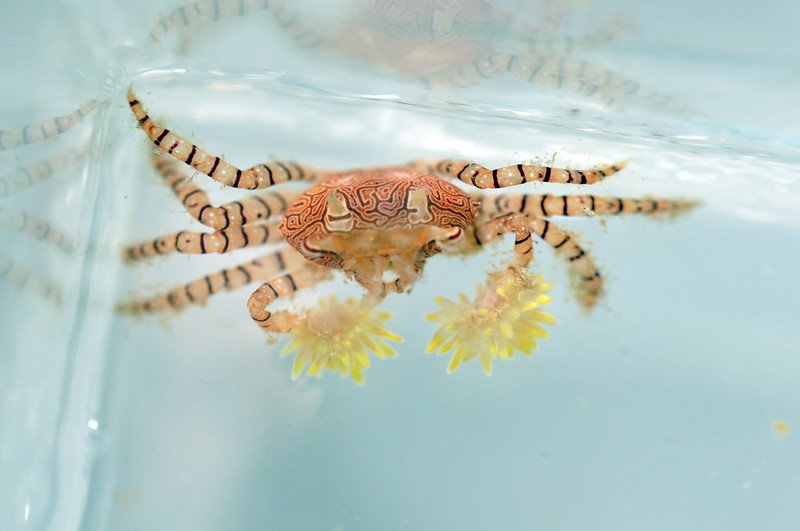
- Family: Xanthidae
- Origin: Madagascar, Taiwan, New Caledonia, Hawaii
- Scientific Name: Lybia Edmondsoni
- Common Name: Pom Pom Crab
- Diet: High-quality sinking flakes and pellets, algae, and freeze-dried meaty foods
- Size: 1-inch adult size
- Lifespan: 1-2 years in captivity
- Tank Size: 5 gallons
- Temperature: 68-78 °F
- pH: 6.2-7.2
- kH: 1-5
These cheerleading crabs stand out due to the little patches of hair they grow in their claws that make them look like they’re holding pom-poms. These hairs serve as a means of collecting food, making it easy for these tiny crabs to also feast on some algae.
They spend all their time in the water, and it’s advised to keep your water level low due to them having a notorious reputation for escaping. They’re relatively easy to care for, just by feeding them and giving them a good environment.
They make good tank mates due to their peaceful nature and can therefore be paired with other crabs and some fish.
7. Thai Micro Crab
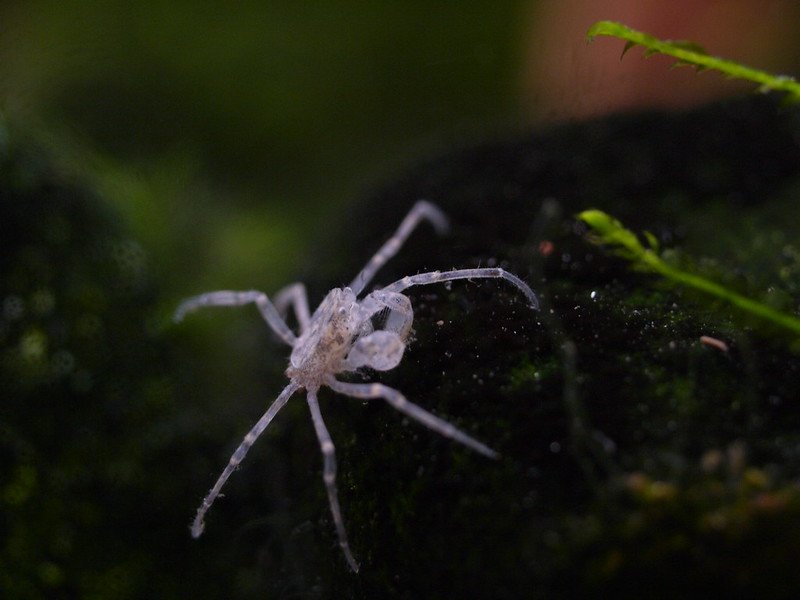
- Family: Hymenosomatidae
- Origin: Thailand
- Scientific Name: Limnopilos naiyanetri
- Common Name: Thai Micro Crab
- Diet: algae, biofilm, or decaying plant matter.
- Size: 1/2 inch adult size
- Lifespan: 1-2 years in captivity
- Tank Size: 5 gallons
- Temperature: 72-82 °F
- pH: 6.5-8.0
- kH: 6-15
These crabs look like little spiders and are rare as they’re only found in one specific river in Thailand. They have long spidery legs in comparison to their small body, which is silvery in color and spotted.
They’re quite shy and like to hide behind caves and plants and keep to themselves to scavenge and find any treats. They’re mostly plant-eaters and don’t eat much either, so you don’t have to feed them often.
They’re also fully aquatic, so you wouldn’t need a dry space for them like many other crabs, and you could even get away with a smaller tank, as they don’t need much space at all.
8. Matano Crab
- Family: Gecarcinidae
- Origin: Indonesia
- Scientific Name: Syntripsa Matannensis
- Common Name: Matano Crab
- Diet: Algae, dead organic matter, brine shrimps, and plant matter
- Size: 1-2 inch adult size
- Lifespan: 3 years in captivity
- Tank Size: 20 gallons
- Temperature: 77-86 °F
- pH: 7.3-8.5
- kH: 3-10
These crabs sport a beautiful purple color and white joints that match their white eyestalks. The males have larger claws and bodies than the females. They also tend to be fully aquatic.
Matano crabs have a reputation for being aggressive; you’ll notice this if you keep them beside some snails and fish. Like some crabs, they are nocturnal, so you’ll notice them scampering about into the late hours. The males also are territorial and won’t tolerate other males of their species.
They also are great escape artists! So be wary and keep the tank sealed at all times as they will take any opportunity to escape.
As scavengers, these crabs are not too picky with their food and eat dead organic matter like fish.
9. Rainbow Land Crab
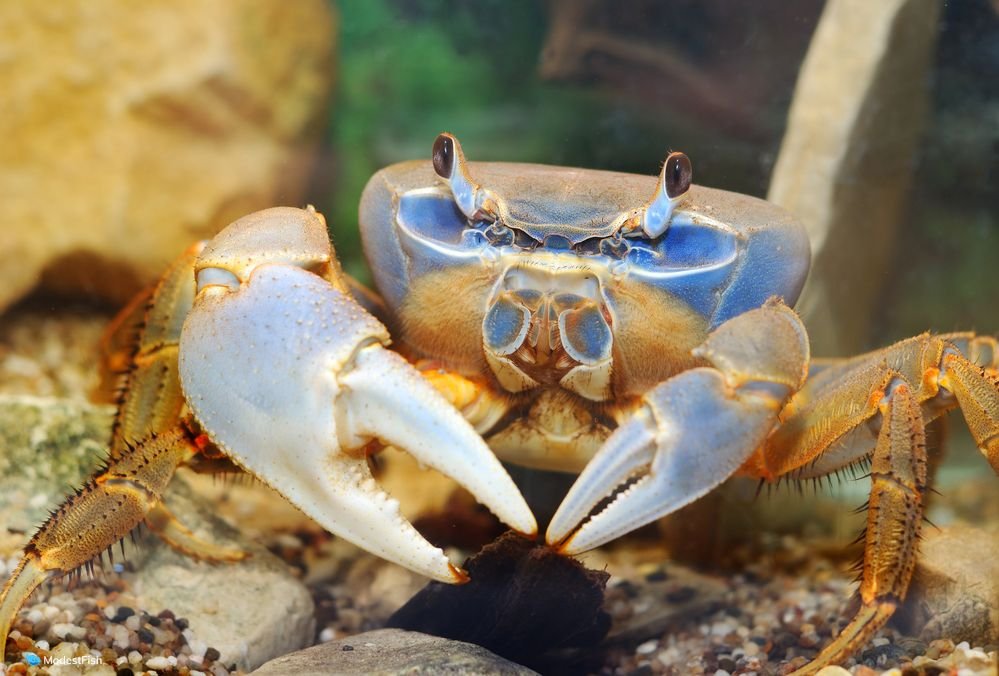
- Family: Gecarcinidae
- Origin: West Africa
- Scientific Name: Cardisoma armatum
- Common Name: Rainbow Crab
- Diet: Plant matter, fruits, and dead matter
- Size: 3-4 inch adult size
- Lifespan: 8 years in captivity
- Tank Size: 20 gallons
- Temperature: 75-85 °F
- pH: 7.0-7.5
- kH: 2-10
Rainbow Crabs are stunning due to their bright colors and distinctive eyes that look like they’re wearing a pair of goggles. Their purplish bodies have hints of blue, and their legs range between orange and red.
You’ll need to provide some dry areas, which give them some comfort to come out at night to have a bite to eat.
Rainbow crabs have tendencies to be crabby and can end up killing their own kind; they’re not the most social creatures, so having them alone in a tank is best. It’s important to feed them well; if they get hungry, they’ll start destroying the terrestrial tank plants to have a bite.
10. Gold Claw Crab
- Family: Ocypodidae
- Origin: West Africa, the Western Atlantic, the Eastern Pacific, Indo-Pacific
- Scientific Name: Uca Minar
- Common Name: Fiddler Crab
- Diet: Nutritional flakes/pellets and brine shrimp, blood worms, plankton, seaweed, and zucchini
- Size: 2 inches adult size
- Lifespan: 3 years in captivity
- Tank Size: For one to four fiddler crabs, a 10-gallon aquarium would be needed
- Temperature: 75-85 °F
- pH: 8.0-8.2
- kH: 12-30
These are fiddler crabs but get their name from their gold claw. Males have a large claw that is striking yellow-golden, and females have a smaller one. These gold claw fiddlers don’t get on with plants, which differentiates them from regular fiddler crabs.
They like to dig deep and burrow, climb around, and can be very active. You need to be wary and keep the lid on your tank if you have these crafty crustaceans about.
Regarding diet and tank mates, they meet the same requirements as fiddler crabs.
11. Red Apple Crab
- Family: Sesarmidae
- Origin: Indonesia, Malaysia & Thailand
- Scientific Name: Metasesarma Aubryi
- Common Name: Red Apple Crab
- Diet: Plant matter, fruit, weeds, and some protein
- Size: 2 inches adult size
- Lifespan: 2-5 years in captivity
- Tank Size: 5-10 gallons
- Temperature: 75-82 °F
- pH: 7.5-8.0
- kH: 4-10
This crab changes colors depending on its mood. When they feel good in their own skin (shell!), they turn a bright red, and when down in the dumps, a rust-brown. These crabs are fairly tolerant as long as there are enough hideouts. You can pair them up with their own species, but with other crabs, they may display aggression, so avoid this!
They like some terrestrial areas, so keep some dry parts for them to burrow around in.
They don’t fuss over what you feed them, though they do prefer more fruit and veggies than other crabs who prefer meat. They also like various dried leaves and moss, so if you have any in your garden, add them to your tank.
12. Marble Batik Crab
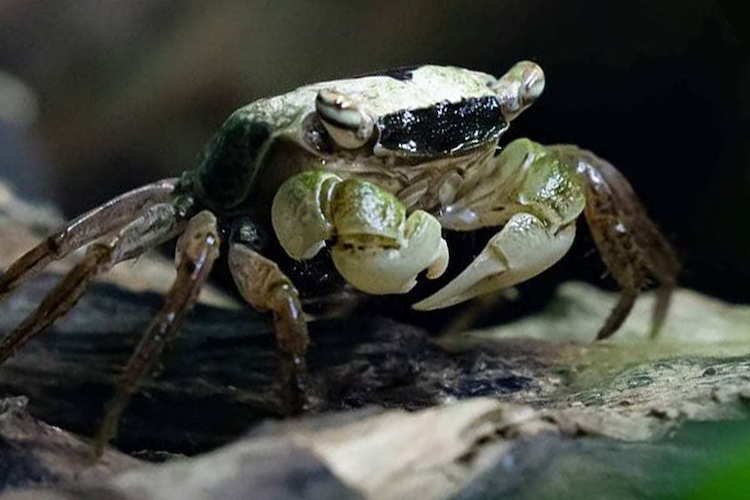
- Family: Pachygrapsus Marmoratus
- Origin: Southeast Asia
- Scientific Name: Metasesarma obesum
- Common Name: Marble Batik Crab
- Diet: High-quality fish, dried veggies or fruit, and protein matter
- Size: 3-5 inches adult size
- Lifespan: 3 years in captivity
- Tank Size: 15-20 gallons
- Temperature: 75-82 °F
- pH: 7.5-8.0
- kH: 4-10
This crab gets its name from having a smooth marble square-shaped body, which tends to be green, but each marble batik crab carries different shades of green with different patterns, similar to marble!
It prefers some dry area and can spend about 50% of its time there, so provide plenty of sand for it to scurry about in.
This crab is good at keeping the tank clean and consumes all dead matter in all its scavenging glory. It doesn’t do well with other species of crabs, so you could pair it up with its own kind.
13. Orange Arm Borneo Crab
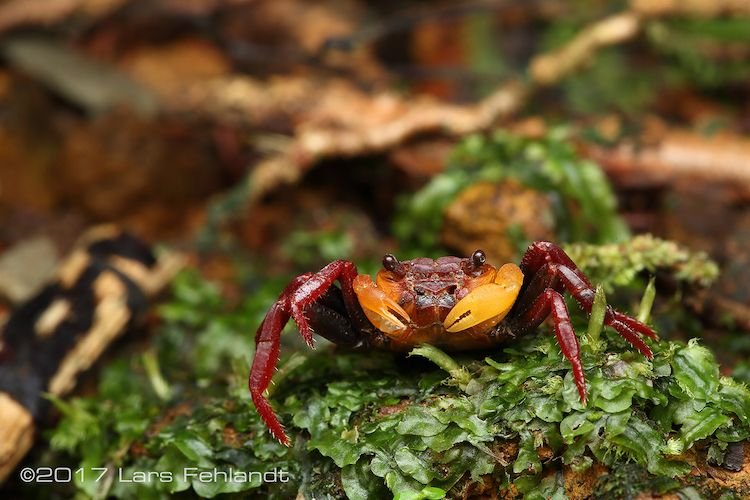
- Family: Geosesarma
- Origin: Indonesia
- Scientific Name: Lepidothelphusa sp.
- Common Name: Orange Arm Borneo Crab
- Diet: Brine shrimp, fruits & veggies, and earthworms
- Size: 2 inches adult size
- Lifespan: 3 years in captivity
- Tank Size: 5 gallons
- Temperature: 75-82 °F
- pH: 7.5-8.0
- kH: 4-10
These attractive crabs get their name from their orange arms. The males have hair on their claws whilst the females are hairless. They add a real flavor to the tank with their entertaining nature and loving to “sunbathe” on dry terrain with their legs dangling into the water!
They’re easy to care for, with just a requirement for dry terrain to allow burrowing and relaxing about.
Luckily, these crabs are social and prefer company to isolation. Just be careful with adding more larger tank mates as these crabs are small, which makes them vulnerable.
Good Tank Mates for Freshwater Crabs
Many crabs do well in groups of their own species. It’s recommended to pair a single male with two females as there’s always aggression when there’s more than one male of the same species involved. In some cases, some freshwater crabs don’t do well with their own species, like the Matano crab, for instance.
The other thing to bear in mind would be the size of the crab; most of them are rather small, so avoid large fish that could either intimidate or eat your crab! So, stick to similarly-sized fish. Another option would be freshwater aquarium snails.
Examples for good tank mates:
- Neocaridina shrimp
- Ghost Shrimp
- Ramshorn Snails
- Nerite Snails
- Pygmy Corydoras
Bad tank mates are any fish larger than your crab, any aggressive crab species, or fish.
Examples for bad tank mates:
- Goldfish
- Cichlids
- Angelfish
Quick Word on Molting Crabs
Just like humans shed their skin, crabs need to shed the outer layer of their shell necessary for their healthy growth. This process can take from 15 minutes to 3 hours, depending on the species. You’ll see them using their legs to push their body out through the gap at the back of their body.
Lastly, the lining on the gills will be pulled out through the mouth and will also be shed. So don’t be alarmed thinking your crab is dying, especially because your crab will go from a happy scuttling scavenger to a paranoid reserved crustacean.
Are Freshwater Crabs Right for You?
These fascinating invertebrates have plenty of character and awesome temperaments in comparison to fish – so if you wish to explore other aquatic creatures that have more to give, then consider crabs.
A crab can really revive a tank and become something that you can marvel at every day. The tiny ones are cute, colorful and each come with their own unique character, some being shy and others being cunning and active, making them super entertaining to watch.
Whichever species has caught your attention, it’s important you read about it and research everything you need to know.

Love the content good info